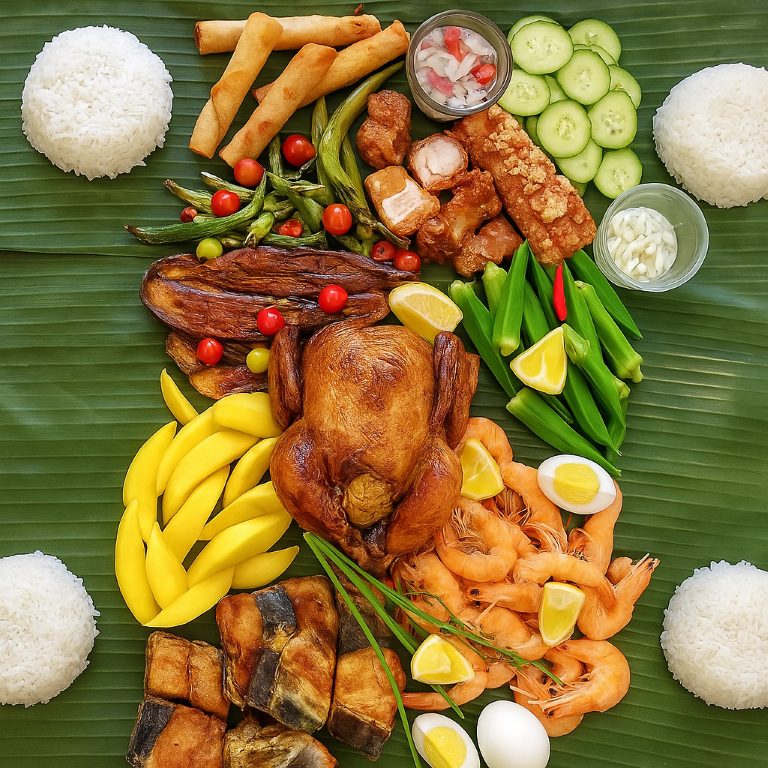Picture this: You’re at a potluck with a lechon (crispy roast pig), a platter of pancit (stir-fried noodles), and a bowl of kinilaw (ceviche-style fish). It’s a feast that feels familiar, but also… not. That’s because Filipino food isn’t just Filipino. It’s a time capsule of centuries of trade, colonization, and cultural mashups—like a culinary Frankenstein (but way tastier).
If you’ve ever wondered why Filipino dishes taste like a globe-trotting adventure, let’s rewind the clock. From ancient rice terraces to Spanish galleons and Chinese trading ships, here’s how Filipino food became the ultimate remix.
1. Indigenous Roots: The OG Flavors
Long before colonizers arrived, Filipinos were farming, fishing, and fermenting their way to deliciousness.
Ingredients:
- Rice: The backbone of every meal, grown in iconic Ifugao rice terraces (a UNESCO wonder older than the Pyramids!).
- Coconut: Milk, vinegar, oil—they used every part.
- Seafood & tropical fruits: Think mangoes, bananas, and fish caught fresh daily.
Cooking Hacks:
- Vinegar & fermentation: To preserve food in the tropics. Bagoong (fermented shrimp paste) and burong isda (fermented fish) added tangy depth.
- Kinilaw: The ancestor of ceviche—raw fish “cooked” in vinegar and calamansi lime.
Pro tip: Try adding coconut vinegar to your next marinade. It’s the secret to that adobo zing!
2. Chinese Traders: The Original Fusion Chefs
Around the 9th century, Chinese merchants sailed in, bringing noodles, woks, and a love of dumplings.
What They Gave Us:
- Pancit: Stir-fried noodles that’s the life of every birthday party (long noodles = long life!).
- Lumpia: Spring rolls so crispy, they’ll ruin egg rolls for you.
- Siopao: Steamed buns stuffed with pork—Filipino dim sum at its finest.
Fun Fact: The word pancit comes from Hokkien Chinese pian i sit, meaning “something conveniently cooked.” Basically, ancient fast food.
Legacy Today: Spot the Chinese influence in toyo (soy sauce) in your adobo or tokwa’t baboy (tofu and pork salad).
3. Spanish Colonizers: 300 Years of Stews & Fiestas
When Spain rolled in during the 1500s, they didn’t just bring religion—they brought paella, chorizo, and a love of fiestas.
Game-Changers:
- New Ingredients: Tomatoes, potatoes, corn, and chili peppers (via Mexico, thanks to the Manila-Acapulco trade route).
- Cooking Techniques: Braising and stewing. Adobo (from the Spanish adobar, “to marinate”) became a vinegar-rich staple.
- Fiesta Culture: Lechon (whole roast pig) became the centerpiece of every celebration.
Wait, But…
- Chocolate: Spaniards introduced cacao, leading to tsokolate (thick hot chocolate) paired with puto (rice cakes).
- Desserts: Leche flan (creme caramel) and ensaymada (cheesy buns) are Spanish AF.
Pro Tip: Host a fiesta at home! Serve caldereta (tomato-beef stew) and pretend you’re in a Manila courtyard.
4. The Galleon Trade: Mexico’s Sneaky Influence
For 250 years, Spanish galleons sailed between Manila and Acapulco, swapping goods (and flavors).
What Crossed the Pacific:
- Mexican chilis: Filipinos swapped them for local siling labuyo, birthing dishes like bicol express (spicy coconut stew).
- Avocados: Originally from Mexico, now starring in Filipino halo-halo (shaved ice dessert).
- Champorado: Chocolate rice porridge inspired by Mexican champurrado.
Fun Fact: The tamales you find in Pampanga? A direct descendant of Mexican tamales, adapted with rice flour and coconut milk.
5. American Era: Fast Food & Spam (Yes, Spam)
After Spain left in 1898, the U.S. took over, bringing canned goods and a love of convenience.
Modern Twists:
- Spam: Filipinos are the world’s second-biggest Spam fans (after Hawaii). Try spamsilog (Spam with garlic rice and egg).
- Jollibee: The Filipino answer to McDonald’s, mixing fried chicken, spaghetti, and peach mango pie.
But… Indigenous, Chinese, and Spanish roots still shine. Adobo stayed saucy, pancit kept its wok hei, and kinilaw never lost its tang.
6. How It All Melts Together Today
Filipino food isn’t a “fusion” trend—it’s a centuries-old conversation between cultures.
On Your Plate:
- Kare-Kare: Indigenous peanuts + Spanish oxtail stew + Chinese bagoong.
- Halo-Halo: Japanese mochi + Mexican avocado + Spanish leche flan + local ube.
- Chicken Sopas: American macaroni + Spanish milk broth + Filipino veggies.
For Home Cooks: Don’t stress about “authenticity.” Filipino cuisine has always been about adapting. Use that Instant Pot for adobo, swap shrimp for pork in sinigang, or add Sriracha to bicol express.
Why Filipino Food Still Stands Out
Other cuisines have similar mixes, but Filipino food keeps it real. There’s no pretense—just hearty, bold flavors that say, “Come eat, you’re family.”
Compare It To:
- Peruvian food: A blend of Indigenous, Spanish, and Japanese.
- Cajun cuisine: French techniques + Southern ingredients.
- Filipino food: All of the above, plus a karaoke machine and a grandma forcing seconds on you.
Hungry for History? Try These Recipes
- Indigenous: Kinilaw (citrus-cured fish with chili and ginger).
- Chinese-Filipino: Pancit Canton (stir-fried noodles with veggies and pork).
- Spanish-Filipino: Chicken Galantina (stuffed chicken, a holiday must).
Pro Tip: Check out our Top 10 Filipino Dishes You Must Try for more inspo!
Final Bite
Filipino food isn’t just about who colonized or traded with whom. It’s about a people who took what the world gave them and made it their own—a little sour, a little salty, and always served with extra rice. So next time you dip a lumpia in vinegar or savor halo-halo, remember: You’re tasting history. And it’s delicious.
Craving more? Dive into our guide: Filipino Food: A Guide to the Best Dishes & Recipes to see how it all stacks up.



[…] Hungry for more? Check out our guide to The History of Filipino Food. […]